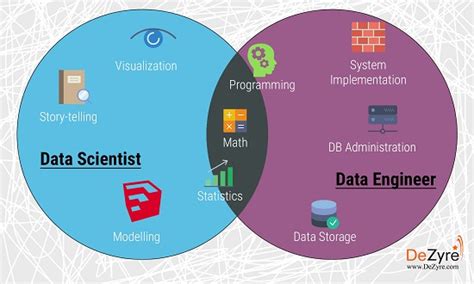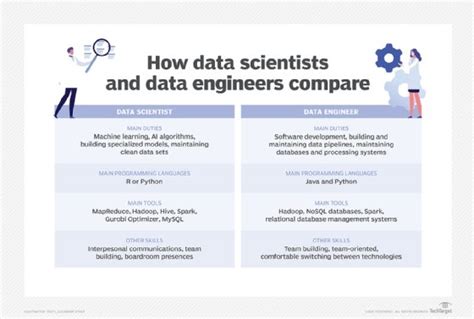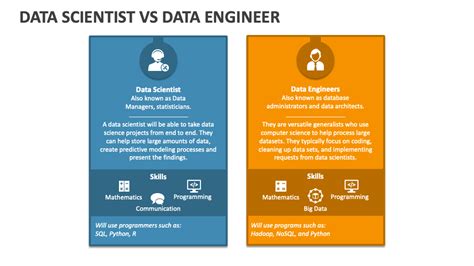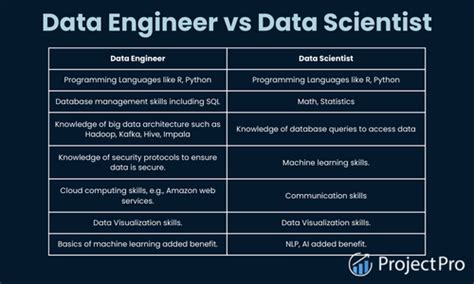Data science and data engineering are two distinct yet interconnected fields that play crucial roles in the development and implementation of data-driven solutions. The primary difference between a data scientist and a data engineer lies in their areas of focus, skills, and responsibilities. While data scientists are concerned with extracting insights and knowledge from data, data engineers are responsible for designing, building, and maintaining the infrastructure that supports the data science lifecycle.
According to a report by Glassdoor, the average salary for a data scientist in the United States is around $118,000 per year, with a growth rate of 14% per annum. In contrast, data engineers can expect an average salary of $141,000 per year, with a growth rate of 10% per annum. These figures indicate a high demand for professionals with expertise in both data science and data engineering.
From a technical standpoint, data scientists typically require a strong foundation in statistical modeling, machine learning, and programming languages such as Python, R, or SQL. They must also possess excellent communication skills to effectively convey complex findings to stakeholders. Data engineers, on the other hand, need to have expertise in software engineering, data architecture, and distributed systems, with proficiency in programming languages like Java, Scala, or Python.
Key Points
- Data scientists focus on extracting insights from data, while data engineers build and maintain the supporting infrastructure.
- Data scientists require strong statistical and programming skills, while data engineers need expertise in software engineering and data architecture.
- Both roles are in high demand, with average salaries ranging from $118,000 to $141,000 per year in the United States.
- Data scientists and data engineers must work together to develop and implement effective data-driven solutions.
- Professionals in both fields must stay up-to-date with emerging trends and technologies, such as cloud computing, artificial intelligence, and the Internet of Things (IoT).
Primary Responsibilities of Data Scientists and Data Engineers

Data scientists are responsible for collecting, analyzing, and interpreting complex data to gain insights and inform business decisions. They use various techniques, including machine learning, statistical modeling, and data visualization, to extract meaningful patterns and trends from large datasets. Some of the primary responsibilities of data scientists include:
- Developing and implementing predictive models to forecast business outcomes.
- Conducting exploratory data analysis to identify areas of improvement.
- Creating data visualizations to communicate complex findings to stakeholders.
- Collaborating with cross-functional teams to integrate data-driven insights into business strategies.
Data engineers, on the other hand, are responsible for designing, building, and maintaining the infrastructure that supports the data science lifecycle. Their primary responsibilities include:
- Developing and implementing data pipelines to extract, transform, and load data into various systems.
- Designing and implementing data architectures to support scalability and performance.
- Ensuring data quality and integrity through data validation and testing.
- Collaborating with data scientists to integrate data-driven insights into business applications.
Data Science vs Data Engineering: Key Differences
While both data scientists and data engineers play critical roles in the development and implementation of data-driven solutions, there are key differences between the two fields. Some of the primary differences include:
| Category | Data Scientist | Data Engineer |
|---|---|---|
| Primary Focus | Extracting insights from data | Building and maintaining data infrastructure |
| Technical Skills | Statistical modeling, machine learning, programming languages (Python, R, SQL) | Software engineering, data architecture, distributed systems, programming languages (Java, Scala, Python) |
| Communication Skills | Excellent communication skills to convey complex findings to stakeholders | Good communication skills to collaborate with cross-functional teams |
| Salary Range | $118,000 per year (average) | $141,000 per year (average) |

Emerging Trends and Technologies in Data Science and Data Engineering

The fields of data science and data engineering are constantly evolving, with emerging trends and technologies transforming the way organizations approach data-driven decision-making. Some of the key trends and technologies include:
- Cloud computing: The adoption of cloud-based infrastructure is increasing, enabling organizations to scale their data storage and processing capabilities more efficiently.
- Artificial intelligence (AI) and machine learning (ML): The use of AI and ML is becoming more prevalent, enabling organizations to automate complex tasks and gain deeper insights from their data.
- Internet of Things (IoT): The proliferation of IoT devices is generating vast amounts of data, which organizations can leverage to improve operational efficiency and develop new business models.
- Big data analytics: The increasing volume, velocity, and variety of data are driving the adoption of big data analytics, enabling organizations to extract insights from large, complex datasets.
Future Outlook and Career Prospects
The demand for professionals with expertise in data science and data engineering is expected to continue growing, driven by the increasing adoption of data-driven decision-making across industries. According to a report by IBM, the number of data science and analytics job postings is expected to increase by 14% per annum, with the global data science market projected to reach $140 billion by 2025.
To succeed in these fields, professionals must stay up-to-date with emerging trends and technologies, while developing a strong foundation in statistical modeling, machine learning, programming languages, and software engineering. By doing so, they can unlock new career opportunities and drive business growth and innovation in an increasingly data-driven world.
What is the primary difference between a data scientist and a data engineer?
+The primary difference between a data scientist and a data engineer lies in their areas of focus, skills, and responsibilities. Data scientists are concerned with extracting insights and knowledge from data, while data engineers are responsible for designing, building, and maintaining the infrastructure that supports the data science lifecycle.
What are the key skills required for a data scientist?
+Data scientists require a strong foundation in statistical modeling, machine learning, and programming languages such as Python, R, or SQL. They must also possess excellent communication skills to effectively convey complex findings to stakeholders.
What is the average salary range for data scientists and data engineers in the United States?
+According to Glassdoor, the average salary for a data scientist in the United States is around 118,000 per year, while data engineers can expect an average salary of 141,000 per year.
